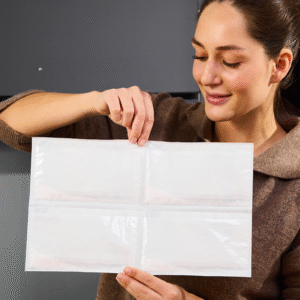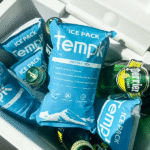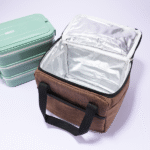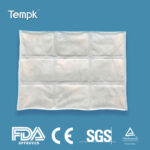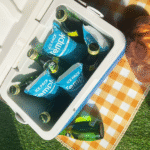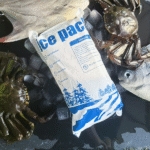Hoja de bolsa de hielo seco cerca de mí: Cómo encontrar & Úsalos en 2025
Las láminas de hielo seco son flexibles., Refrigerante súper frío utilizado para enviar alimentos congelados, productos farmacéuticos y muestras de laboratorio. Cuando los necesitas rápidamente, la pregunta se vuelve “¿Dónde puedo encontrar un hoja de hielo seco cerca de mí y ¿cómo lo uso de forma segura??" Esta guía responde a esa pregunta explicando qué son las capas de hielo seco., cómo dimensionarlos, dónde comprarlos localmente y cómo manipularlos y eliminarlos de manera responsable. Si sigue los consejos siguientes podrá enviar mercancías a –78 °C sin fugas ni desorden y cumplir con 2025 reglas de seguridad. Si ejecuta un kit de comida de comercio electrónico, administrar una clínica o simplemente necesita mantener el pescado congelado, Aprenderá cómo las láminas de hielo seco agilizan su cadena de frío..
¿Qué son las láminas de hielo seco y por qué elegirlas en lugar de las de gel?? Conozca las diferencias entre las mantas de hielo seco, Ladrillos de gel y materiales de cambio de fase..
Cómo encontrar láminas de hielo seco cerca de usted. Describimos herramientas en línea, principales minoristas, farmacias, Proveedores de gas y proveedores especializados de cadena de frío..
Estrategias de tamaño y embalaje.. Descubra cómo elegir el espesor y la cobertura de la lámina para lograr tiempos de retención de 24 a 72 horas..
Manejo seguro, almacenamiento y eliminación. Siga las pautas oficiales sobre ventilación., equipo de protección y eliminación de FedEx y los departamentos de seguridad de la universidad.
2025 tendencias y conocimientos del mercado. Obtenga más información sobre las tarjetas empaquetadas impresas, Películas y registradores de datos sin PFAS que impulsan el cambio en la industria.
Qué define una hoja de bolsa de hielo seco cerca de mí y por qué es importante?
Definición y beneficios clave
Una lámina de hielo seco es un refrigerante flexible lleno de gránulos de CO₂ sólidos o de polímero superabsorbente. (SAVIA) células que se congelan para formar una manta rígida. A diferencia de los pellets sueltos, Las sábanas envuelven su producto como una manta., mejorar la “cobertura de los bordes” y reducir las esquinas cálidas. Los paquetes de gel tradicionales funcionan a una temperatura de 0 a 5 °C y se funden en agua., mientras que las capas de hielo seco mantienen temperaturas de hasta -78 °C sin dejar residuos líquidos. En 2025, Muchos programas de envío adoptan hojas porque se empaquetan firmemente en cajas de formas extrañas., Pesan menos que los bloques y cumplen con diferentes bandas de temperatura cuando se combinan con paquetes de gel o PCM..
Las ventajas clave incluyen:
Temperatura ultrabaja sin residuos – El hielo seco se sublima directamente en gas., para que no haya agua que pueda dañar los productos.
Cobertura flexible – Las láminas se envuelven alrededor de las paredes del producto para un enfriamiento uniforme y menos puntos cálidos..
Mayor duración – Con espesor y aislamiento adecuados, las láminas pueden mantener temperaturas congeladas durante 24 a 72 horas.
Riesgo de manipulación reducido – Comparado con pellets sueltos, Las láminas minimizan la liberación de CO₂ y son más fáciles de eliminar..
Cumplimiento simplificado – Las hojas de SAP a base de agua evitan etiquetas de materiales peligrosos, mientras que el verdadero hielo seco (Co₂ sólido) requiere ONU 1845 etiquetas y clase 9 marcas de peligro.
Cómo se comparan las capas de hielo seco con los paquetes de gel y los bloques PCM
La siguiente tabla resume las diferencias clave entre las láminas de hielo seco., Paquetes de gel y materiales de cambio de fase. (PCM) para ayudarle a elegir el refrigerante adecuado para su carril.
| Tipo de refrigerante | Rango de trabajo | Duración típica | Lo que significa para ti |
| Hoja de hielo seco (SAVIA) | Alrededor 0 °C cuando está hidratado; bajo cero cuando se utilizan celdas de CO₂ | 12–48 h para envíos refrigerados, 24–72 h para congelado cuando se combina con aislamiento | Las sábanas livianas se envuelven alrededor de formas extrañas; costo más bajo; más fácil de implementar y eliminar que los PCM. |
| Ladrillos o tejas PCM | −25°C a +25 °C dependiendo de la formulación | 24–96 h | Proporcionar un control estricto de la temperatura para las auditorías.; mayor costo inicial; requieren preacondicionamiento (congelar o calentar). |
| paquetes de gel / ladrillos de hielo | 0 °C a 5 °C | 8–24 H | Simple, Económico e ideal para productos refrigerados.; se derrite en agua y puede filtrarse; no apto para envíos bajo cero. |
Escenarios prácticos
Entregas de kits de comida – Para un carril de 36 horas que envía comidas congeladas, envolver los lados con un 0.5 hoja de pulgadas y agregue una hoja superior adicional. Una marca de comida regional que utilizó este patrón mantuvo los platos principales de pollo por debajo de –10 °C durante 60 horas y reducir las quejas de los clientes en dos tercios.
Envíos farmacéuticos – Para kits de vacunas que requieren –20 °C, usar 1 hojas de una pulgada de espesor y agregue un divisor transpirable para evitar que el vial se agriete. Registre los números de lote para la trazabilidad.
Cargas de temperatura mixta – Combine paquetes de gel en la parte superior con capas de hielo seco que abracen los artículos congelados para crear zonas duales.
Cómo encontrar láminas de hielo seco cerca de usted
Cuando necesitas capas de hielo seco rápidamente, El abastecimiento local puede ahorrar tiempo y reducir los costos de envío.. Estos son los mejores métodos para localizar un proveedor cercano.
Utilice directorios y herramientas de búsqueda en línea
Motores de búsqueda – Ingrese consultas como “proveedores de hielo seco cerca de mí” o “hojas de paquetes de hielo seco” para generar una lista de minoristas y distribuidores cercanos. Muchos operadores mantienen localizadores de tiendas que le permiten filtrar por tipo de producto..
Sitios web de directorio – Sitios como Páginas Amarillas y Yelp enumeran proveedores locales con detalles de contacto y horarios..
Plataformas industriales – Las plataformas de nicho como Dry Ice Supply o Industrial Dry Ice se especializan en productos de cadena de frío y a menudo identifican proveedores que almacenan láminas junto con pellets..
Consulte los principales minoristas y proveedores de gas
Los grandes minoristas y las empresas de gas industrial suelen almacenar hielo seco, especialmente en estados donde el envío en frío es común. Walmart y Home Depot llevar hielo seco y, a veces, hojas precortadas en su sección de congelador. aire y Praxair Suministrar hielo seco en varias formas. (bolitas de arroz, pellets y bloques estándar) y permitir pedidos en línea para recogida local. Airgas también apuesta por el control de calidad: rotan el stock primero en, primero en salir y enviar productos en condiciones rastreables, Contenedores revestidos de acero inoxidable para reducir la sublimaciónairgas.com.
Visitar Farmacias, Fabricantes de comestibles y hielo
Es posible que haya cantidades más pequeñas disponibles en farmacias o supermercados locales., que a veces guardan hielo seco para enviar muestras médicas. Fabricantes de hielo locales También corta bloques y losas y puede suministrar láminas de tamaño personalizado.. Compañía de hielo del oso describe cómo las placas de hielo seco, Los gránulos y los gránulos de grado médico satisfacen necesidades tanto comerciales como personales., desde enfriar grandes cantidades de alimentos hasta crear niebla para eventos. Señalan que el hielo seco es ideal para cortes de luz, viajes de caza/pesca, Transporte de muestras biológicas e incluso efectos escénicos..
Considere proveedores especializados de cadena de frío
Si envías regularmente, construir una relación con un proveedor dedicado de la cadena de frío. Estos proveedores pueden personalizar los tamaños de las hojas., ofrecer compras al por mayor y garantizar una disponibilidad constante. También podrán impartir formación, kits de aislamiento y registradores de datos de rendimiento. Empresas como Tempk diseñan kits con tarjetas impresas y guías de hidratación para que cada caja esté empaquetada correctamente..
Dimensionamiento y embalaje: ¿Cuántas hojas necesitas??
El tamaño adecuado garantiza que su carga útil permanezca congelada sin desperdicio. En general, Elija el espesor de la hoja según la duración de la ruta y el entorno.. Las reglas siguientes simplifican el proceso.:
Haga coincidir la longitud de la hoja con las paredes de la caja – Para una hielera de 12×10×8 pulgadas, corte o doble hojas para revestir las cuatro paredes y el fondo. Añade una sábana superior para rutas largas..
Seleccionar espesor por duración – Empezar con 0.5 Hojas de pulgadas de espesor para envíos de 24 a 36 horas.; convidar a 1.0 hojas en pulgadas para 48 horas y 1.25 hojas en pulgadas para 72 horas.
Utilice más capas que espesor – Agregar capas adicionales alrededor de los lados a menudo mejora el tiempo de retención más que simplemente aumentar el espesor.
Planificar un buffer - Agregar 20 % Es hora de tener en cuenta los retrasos en los servicios de mensajería y el clima cálido..
Registrar datos clave – Antes del envío, registro de masa de carga útil, perfil ambiental, tipo de aislamiento, espesor y recuento de la hoja.
A continuación se muestra una relación aproximada entre el espesor de la lámina y el tiempo de retención., basado en el rendimiento típico. Valida siempre con tus productos y carriles.
Mesa: Cobertura y propósito de la hoja
| Cobertura | Uso típico | Lo que significa para ti |
| 4 paneles de pared | Todas las rutas | Minimiza los "puntos calientes" y nivela la temperatura.. |
| Sábana superior (1–2 paneles) | 48–carriles de 72 h | Añade seguro contra retrasos en el servicio de mensajería.. |
| Sábana bajera (1 panel) | Todas las rutas | Protege contra pisos calientes de camiones y reduce el retroceso. |
Consejos de usuario para empacar
Pre-enfriar todo – Enfríe el transportador y la carga útil antes de agregar hojas para que no desperdicien energía al reducir la temperatura..
Envolver y tapar – Los lados de la línea primero, cargar producto, luego coloque la hoja superior. Este patrón "sin aplastamiento" protege artículos frágiles como viales.
Evitar huecos – Utilice material de relleno o espuma para eliminar el espacio libre y evitar que las hojas se muevan..
Prueba piloto – Ejecute un piloto de 10 cajas en las peores condiciones. (olas de calor, fines de semana largos). Ajustar la cobertura según las temperaturas de llegada..
Imprimir tarjetas para empacar – Coloque instrucciones paso a paso dentro de cada kit para reducir el tiempo de entrenamiento y garantizar la coherencia..
Ejemplo de caso: Un hospital regional realizó una prueba piloto utilizando 1.25 láminas en pulgadas para abastecer a clínicas 1,000 millas de distancia. Combinando una cobertura total de la pared, una hoja de refuerzo superior y tarjetas impresas, mantuvieron –15 °C durante 72 horas con cero excursiones, permitiéndoles enviar productos biológicos de forma segura sin transporte nocturno.
Seguridad: Manejo, Almacenamiento, Transporte & Desecho
El hielo seco es extremadamente frío y libera dióxido de carbono.. Para proteger a las personas y los productos, Siga estos principios de seguridad de los transportistas y los departamentos de seguridad de las universidades..
Pautas de manejo
Protección contra el desgaste – Utilice guantes aislantes y protección para los ojos.; Evite el contacto directo con la piel para evitar la congelación.. La Universidad de Edimburgo advierte que el hielo seco puede provocar quemaduras por frío y congelación, e incluso una exposición breve puede ser peligrosa.
La ventilación es crítica – Utilice hielo seco sólo en áreas abiertas o bien ventiladas para evitar la acumulación de CO₂.. Concentraciones de CO₂ superiores 5,000 ppm durante ocho horas o 15,000 ppm sobre 15 minutos exceden los límites de exposición en el lugar de trabajo.
Nunca sellarlo – No poner hielo seco en recipientes herméticos; La presión puede acumularse y provocar una explosión.. FedEx 2025 la ayuda de trabajo especifica el uso de tableros de fibra, cajas de plástico o madera con orificios de ventilación, y prohíbe las bolsas de plástico selladas.
utilizar herramientas – Manejar las piezas con pinzas o palas.; Evite inclinarse sobre los contenedores de almacenamiento y mantenga las tapas cerradas cuando no esté en uso..
Mejores prácticas de almacenamiento
Elige el contenedor adecuado – Utilizar cajas aisladas que permitan la salida del gas.. FedEx prohíbe los bidones de acero y recomienda la espuma de poliestireno sólo como aislamiento interior, no como embalaje exterior.
Evite las habitaciones selladas – No almacenar hielo seco en congeladores., refrigeradores o habitaciones sin ventilación. Mantenga los contenedores en lugares secos., espacios bien ventilados y alejados de fuentes de calor.
Rotar material – Seguir primero en, Rotación de primero en salir para reducir la sublimación y evitar el uso de hojas viejas.; Airgas enfatiza esta práctica para el control de calidadairgas.com.
Acceso seguro – Almacene el hielo seco en un área segura y evite el acceso no autorizado, especialmente niños o personal no capacitado.
Requisitos de transporte
Etiquetado adecuado – Si se utilizan láminas sólidas de CO₂, marque los paquetes con “hielo seco” o “dióxido de carbono”, sólido,"la ONU 1845 número y peso neto. FedEx requiere una clase 9 etiqueta de peligro que mida al menos 100 mm de lado.
Embalaje ventilado – Asegúrese de que las cajas ventilen el gas.; use orificios o tapones de ventilación cuando use refrigeradores de plástico.
Límites del transportista – FedEx limita el hielo seco en 200 kg por paquete e instruye a los transportistas a confirmar las cantidades permitidas para envíos aéreos. Los transportistas pueden tener límites de peso separados para las rutas terrestres y aéreas..
Nunca transportar en vehículos cerrados. – Las directrices universitarias advierten contra el transporte de hielo seco en los compartimentos de pasajeros; ventile con aire exterior si el transporte es inevitable.
Desecho: Prácticas Responsables y Legales
Permitir la sublimación – La forma más segura de deshacerse del hielo seco es dejar que se sublime en un área exterior bien ventilada.. El hielo seco se sublima directamente de sólido a gas a –78 °C.
Evite los contenedores sellados – Nunca arrojes bolsas de hielo seco a los contenedores de basura., lavabos o inodoros; Los espacios sellados pueden atrapar gas y causar acumulación de presión o asfixia..
Utilice instalaciones de eliminación – Algunas instalaciones de residuos peligrosos aceptan hielo seco.; llame con anticipación para verificar.
Contrata profesionales para grandes volúmenes – Para grandes cantidades o eliminación urgente, Considere contratar un servicio de eliminación que pueda neutralizar el hielo seco de forma segura..
Cómo comprar láminas de hielo seco cerca de usted: Plan paso a paso
Define tus carriles y objetivos. Trace sus tres rutas de envío principales y las temperaturas de llegada objetivo, como “por debajo de –10 °C para 72 horas."
Elija una especificación inicial. Empezar con 1 paredes en pulgadas y una sábana superior más una tarjeta empaquetada impresa; ajustar el espesor después de las pruebas piloto.
Localizar proveedores. Utilice herramientas de búsqueda, consultar minoristas, Póngase en contacto con las compañías de gas y contrate a un especialista en cadena de frío..
ejecutar un piloto. Barco 10 cajas a lo largo de su carril más difícil y registre temperaturas con registradores de datos económicos.
Ajustar la especificación. Ajuste la cobertura según las fallas: agregue una lámina de refuerzo superior o aumente el espesor para climas cálidos.
Salir y entrenar. Imprimir tarjetas para empacar, capacitar al personal e implementar primero en, rotación de primero en salir. La estandarización reduce los errores y acelera el embalaje..
Seguimiento y optimización de costos. Calcular el costo por entrega exitosa, incluyendo material, mano de obra, transporte y deterioro. Las láminas más gruesas que evitan un pedido fallido pueden ahorrar dos dígitos en el costo total de frío por kilogramo..
Ejemplo de modelo de costos
Costo de entrega exitosa = (Costo de la hoja + Caja + Mano de obra + Transporte + Etiqueta)
+ (Tasa de fracaso × (Costo del producto + Reenviar + Servicio al cliente))
Si una hoja más gruesa corta las fallas de 4 % a 1 %, Su costo total de envío a menudo cae, liberar presupuesto para marketing o R&D.
Cumplimiento normativo y estándares
Las regulaciones garantizan que los envíos sean seguros para los trabajadores, transportistas y destinatarios. En 2025, El cumplimiento se centra en el etiquetado., formación y documentación.
Clasificación de peligro – El verdadero hielo seco es una Clase 9 material peligroso con ONU 1845 designación. Los paquetes deben mostrar el nombre de envío correcto., Número ONU y peso en la misma superficie que la etiqueta de peligro.. Las láminas que contienen solo agua y SAP evitan esta clasificación, pero aún requieren cumplimiento de contacto con alimentos para productos comestibles..
Marcado y etiquetado – FedEx requiere los nombres y direcciones del remitente y del destinatario en el paquete; Las etiquetas deben tener al menos 12 mm de altura cuando el paquete aguanta más de 30 kg de hielo seco. una clase 9 Se debe colocar una etiqueta con siete franjas verticales.; no escribas en la etiqueta.
Documentación – Las facturas aéreas deben indicar “UN 1845, Hielo seco” y enumere la cantidad de paquetes y el peso neto.. El personal capacitado debe preparar los envíos y cumplir con las normas sobre mercancías peligrosas.; Los operadores ofrecen seminarios y soporte telefónico..
Seguridad en el lugar de trabajo – La Universidad de Edimburgo enumera los límites de exposición al CO₂: 5,000 ppm durante ocho horas y 15,000 ppm sobre 15 minutos. Sólo entrenado, Los usuarios competentes deben manipular hielo seco.; Se deben seguir evaluaciones de riesgos.. Directrices adicionales cubren el transporte en ascensores y vehículos..
2025 Desarrollos y tendencias del mercado
Tecnologías emergentes & Prácticas
Menos SKU con mejor cobertura – Muchos transportistas están cambiando a un único tamaño de hoja plegable que se puede cortar o doblar para adaptarse a varias dimensiones de caja., reduciendo la complejidad del inventario.
Tarjetas de embalaje impresas – Las instrucciones laminadas en la bolsa de hojas reducen el tiempo de capacitación y los errores.
Registro de datos en el borde – Pequeños registradores de temperatura verifican el tiempo de espera y generan confianza con clínicas y clientes.
Películas libres de PFAS y sostenibilidad – Los fabricantes están cambiando a revestimientos sin flúor y revestimientos reciclables para satisfacer las demandas medioambientales.. Las innovaciones en materia de eliminación incluyen paquetes de gel biodegradables y envases mejorados que permiten la sublimación controlada..
Reutilizabilidad y validación – Las placas de PCM reutilizables y las mantas de hielo reforzadas reducen el desperdicio y pueden validarse para carriles regulados..
Ideas del mercado
Crecimiento en directo al consumidor (DTC) Los kits de comida y el envío de telemedicina impulsan la demanda de productos ligeros., refrigerantes flexibles. Los sectores farmacéutico y de ciencias biológicas continúan adoptando la trazabilidad y la validación., favorecer los PCM para rangos de temperatura estrechos. Aplicación de la ONU a los transportistas 1845 las etiquetas siguen siendo estrictas, por lo que la capacitación y las listas de verificación son esenciales. Luz, Los paquetes ajustados ayudan a minimizar las dimensiones. (OSCURO) Cargos por peso en una era de recargos por temporada alta., hacer que los paquetes de hojas sean económicamente atractivos.
Preguntas frecuentes
Q1: ¿Cuál es la diferencia entre una lámina de hielo seco y bolitas de hielo seco??
Una lámina de hielo seco es una manta flexible que envuelve la carga y utiliza CO₂ sólido o SAP hidratado para mantener temperaturas bajo cero.. Los pellets son trozos sueltos de CO₂ sólido.. Las sábanas son más fáciles de manejar., Reduzca el riesgo de explosión y proporcione una cobertura más uniforme..
Q2: ¿Cuánto tiempo mantendrá congelado mi envío una lámina de hielo seco??
El tiempo de espera depende del espesor de la hoja., aislamiento y condiciones ambientales. A 0.5 La hoja de pulgadas puede durar entre 24 y 36 horas., mientras 1.25 Las hojas de pulgadas pueden mantener temperaturas congeladas hasta 72 horas en contenedores isotérmicos.
Q3: ¿Puedo reutilizar las láminas de hielo seco??
Sí, si la película permanece intacta y limpia. Realice un seguimiento del número de ciclos y retire las hojas después de cinco a siete usos para evitar roturas y contaminación..
Q4: ¿Las capas de hielo seco son seguras para el contacto con alimentos??
Las láminas de SAP hidratadas son a base de agua y generalmente aptas para alimentos., pero siempre confirme que los materiales cumplan con las regulaciones de contacto con alimentos.. Verdaderas capas de hielo seco (Co₂ sólido) requieren etiquetado y ventilación adecuados para evitar la acumulación de CO₂.
Q5: ¿Cómo desecho las capas de hielo seco sobrantes??
Deje que el hielo seco se sublime al aire libre o en una campana extractora.. Nunca coloque sábanas en contenedores o fregaderos sellados.. Para grandes volúmenes o eliminación urgente, Utilice un servicio profesional o comuníquese con las instalaciones locales de desechos peligrosos..
Resumen & Siguientes pasos
Elegir y utilizar placas de hielo seco localmente requiere comprender su ruta, Seleccionar el espesor adecuado y conseguir proveedores fiables.. Las capas de hielo seco ofrecen temperaturas ultrabajas sin derretirse, Productos envolventes para una mejor cobertura y soporte en carriles de 24 a 72 horas.. Siempre use equipo de protección, use contenedores ventilados y siga las reglas de etiquetado. Planificar un piloto, estandarice sus paquetes y realice un seguimiento de los costos para optimizar la eficiencia.
Listo para poner en práctica estos conocimientos? Mapee sus rutas de envío, encuentre un proveedor cercano utilizando las estrategias de búsqueda anteriores, y pide un juego de sábanas inicial. Ejecute una prueba piloto para validar el tiempo de espera y ajustar la cobertura.. Si necesita orientación personalizada o un kit personalizado, Consulte a un especialista en cadena de frío para diseñar un sistema repetible., solución compatible.
Acerca de Tempk
Tempk se especializa en prácticos kits de cadena de frío para alimentos, envíos farmacéuticos y biotecnológicos. Nuestro desarrollo de productos enfatiza la trazabilidad., tarjetas impresas y materiales libres de PFAS. Proporcionamos kits de muestra y capacitación para ayudar a los equipos a estandarizar el embalaje., medir el rendimiento y escalar las operaciones. Contáctenos para discutir sus carriles y recibir una recomendación personalizada.
Siguiente paso: Visite nuestra página de contacto o llame para solicitar un kit de muestra y una tarjeta de embalaje.






